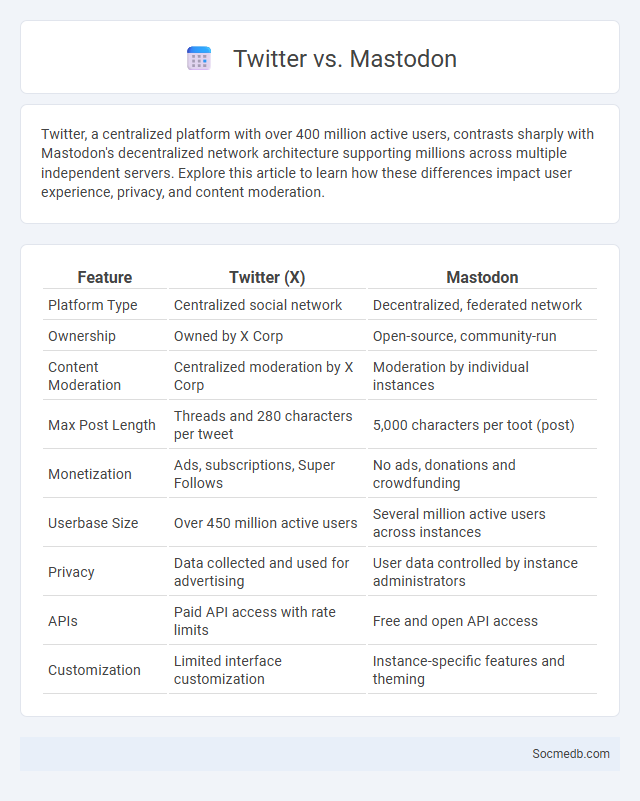
Photo illustration: Twitter vs Mastodon
Twitter, a centralized platform with over 400 million active users, contrasts sharply with Mastodon's decentralized network architecture supporting millions across multiple independent servers. Explore this article to learn how these differences impact user experience, privacy, and content moderation.
Table of Comparison
| Feature | Twitter (X) | Mastodon |
|---|---|---|
| Platform Type | Centralized social network | Decentralized, federated network |
| Ownership | Owned by X Corp | Open-source, community-run |
| Content Moderation | Centralized moderation by X Corp | Moderation by individual instances |
| Max Post Length | Threads and 280 characters per tweet | 5,000 characters per toot (post) |
| Monetization | Ads, subscriptions, Super Follows | No ads, donations and crowdfunding |
| Userbase Size | Over 450 million active users | Several million active users across instances |
| Privacy | Data collected and used for advertising | User data controlled by instance administrators |
| APIs | Paid API access with rate limits | Free and open API access |
| Customization | Limited interface customization | Instance-specific features and theming |
Overview: Twitter, Mastodon, and Trending Topics Explained
Twitter is a global social media platform known for its real-time microblogging and trending topics that influence news cycles and public discourse. Mastodon offers a decentralized alternative, enabling users to join independent servers with open-source software, fostering niche communities and greater content control. Trending topics on these platforms highlight popular conversations, hashtags, and viral content, shaping user engagement and digital culture worldwide.
Key Differences Between Twitter and Mastodon
Twitter operates as a centralized social media platform with a single company controlling user data and content policies, while Mastodon is a decentralized network of independently operated servers (instances) promoting user autonomy and diverse moderation styles. Twitter enforces strict character limits and algorithmic timelines to maximize engagement, whereas Mastodon offers longer posts and chronological feeds prioritizing user control over content visibility. Your choice between the two impacts data privacy, community involvement, and content moderation, with Mastodon appealing to users valuing open-source principles and Twitter favored for its widespread reach and brand presence.
How Trending Topics Work on Twitter
Trending topics on Twitter are determined by an algorithm that identifies rapidly popular hashtags and keywords based on users' current engagement within specific geographic locations or globally. The system tracks real-time data, including tweet volume, velocity, and recent spikes in discussions to surface relevant trends tailored to Your interests. This dynamic process ensures that trending topics reflect the most talked-about events, conversations, and news at any given moment.
Mastodon’s Approach to Trending Discussions
Mastodon employs a decentralized, community-driven model to trending discussions, enabling users to engage with topics based on local server interests rather than a global algorithm. This approach prioritizes user privacy and reduces algorithmic bias, fostering more authentic and diverse conversations. The platform's federated network structure allows trends to emerge organically within distinct communities while maintaining interoperability across the broader Mastodon ecosystem.
Moderation and Community Guidelines Compared
Social media moderation enforces community guidelines to maintain respectful interactions and prevent harmful content such as hate speech, misinformation, and spam. Platforms implement automated tools and human reviewers to monitor user behavior and apply sanctions like content removal or account suspension. Your engagement thrives in a safer, more inclusive environment when moderation aligns effectively with clear, transparent community guidelines.
Privacy and User Control: Twitter vs Mastodon
Twitter and Mastodon differ significantly in privacy and user control, with Twitter operating as a centralized platform that collects extensive user data for targeted advertising, while Mastodon offers a decentralized network where users retain greater control over their data and privacy settings. You can customize privacy levels on Mastodon by choosing specific instances with varying moderation policies, enhancing your control over content and interactions. Mastodon's open-source nature provides transparency and reduces risks of mass data exploitation compared to Twitter's proprietary algorithms and data handling practices.
User Experience: Interface and Features
Social media platforms prioritize intuitive user interfaces featuring streamlined navigation and personalized content feeds to enhance engagement. Interactive features such as multimedia sharing, real-time messaging, and customizable profiles support user connectivity and self-expression. Integration of AI-driven recommendations and accessible design further optimize the user experience across diverse demographics and devices.
Content Discovery and Virality on Both Platforms
Content discovery on social media platforms like Instagram and TikTok relies heavily on their advanced algorithms that analyze user behavior to surface personalized and trending posts. Virality is amplified through features such as Reels and For You Page, which boost visibility by promoting engaging and shareable content to a wider audience. Optimizing your posts with relevant hashtags, engaging captions, and high-quality visuals increases the chances of your content being discovered and shared rapidly across both platforms.
The Role of Algorithms in Trending Topics
Algorithms play a crucial role in determining trending topics on social media by analyzing user behavior, engagement patterns, and content relevance to surface popular posts quickly. Your feed is personalized through complex machine learning models that prioritize content based on factors like recency, user interactions, and network influence. This algorithm-driven curation ensures that trending topics reflect current user interests and viral conversations across platforms like Twitter, Instagram, and TikTok.
Choosing the Best Platform for Real-Time Conversations
Selecting the best social media platform for real-time conversations depends on user engagement features, audience demographics, and response time capabilities. Platforms like Twitter excel with instant interactions and trending topic visibility, while Discord and Clubhouse offer specialized audio and community-driven experiences for live discussions. Analyzing platform analytics and audience preferences ensures effective communication and maximizes real-time conversational impact.
 socmedb.com
socmedb.com